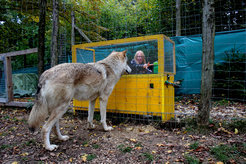Wolves Understand Cause and Effect Better Than Dogs
Study conducted at the Wolf Science Center in Vienna shows that dogs seem to have lost some problem solving abilities when they were domesticated.

Lead author Michelle Lampe of Radboud University explains, “Children learn the principle of cause and effect early on, that if you touch a hot stove you will get burned, for example. Our study has shown that the wolf understands such connections better than our four-legged domesticated companions. It seems wolves are better at working some things out than dogs, which suggests domestication has changed dogs’ cognitive abilities.”
Lampe, Dr. Zsófia Virányi of the University of Veterinary Medicine in Vienna, Dr. Juliane Bräuer of the Max Planck Institute for the Science of Human History and Dr. Juliane Kaminski of the University of Portsmouth in the United Kingdom investigated the reasoning abilities of 14 dogs, including household pets and dogs living in a pack-setting, and 12 human-socialized wolves.
The tests included the animals having to choose between two objects, one containing food and the other empty, to see whether the animals could make use of certain cues to choose the correct container. The cues including communicative cues, such as eye contact and pointing, behavioral cues, such as the human reaching for the container or trying to open the container, and causal cues in the absence of a human, such as the container with food making a noise when shaken.

Both dogs and wolves were able to follow communicative cues to find hidden food. However, in the absence of a human to show them where the food was, the wolves were better able to make inferences from the causal cues. Dr. Kaminski says, “In this experiment, the wolves showed a high understanding of cause and effect, which the dogs lacked.”
One factor complicating the results is that wolves have previously been found to show a greater drive to explore and to remain focused on problems in comparison to dogs. It could be these characteristics, rather than an underlying problem solving ability, that led to the wolves’ success in the present study. “It can’t be ruled out that the differences could be due to wolves being more persistent in exploring than dogs. Dogs are conditioned to receive food from us, whereas wolves have to find food themselves in nature,” states Lampe.
Wolves and dogs equally good at understanding human communicative cues
The wolves’ ability to follow the human communicative cues runs contrary to a commonly held belief that, through the domestication process, dogs have become more adept at understanding and communicating with humans. “The wolves’ use of cues connected to eye-contact was particularly interesting because it may help science better understand the process by which wild animals became our four-legged companions,” explains Dr. Kaminski. “The wolves’ ability to understand human communicative cues after being socialized with humans may have made it possible to become domesticated,” states Dr. Bräuer. In other words, rather than being a product of domestication, the canine ability to understand our communicative cues might have been what enabled their domestication.
The authors note that another compelling aspect of the results is that, in addition to comparing dogs and wolves living under identical conditions with the same history and training regime, the study also compared dogs living in packs to dogs living with human families. Interestingly, the pet dogs did not show any increased ability to understand human communication. Dr. Virányi notes, “We were able to tease apart the influence of domestication from raising and living conditions. Few studies have achieved such strong, clear comparisons, though we must caution, too, that the wolves we studied are used to humans, which needs to be taken into account.”

